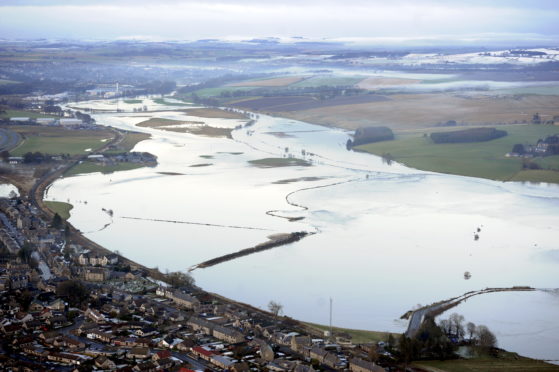The number of properties at risk from flooding will rise by 110,000 over the coming decades, a Scottish Government document has warned.
Homeowners and business owners in susceptible areas have been told they face repeated damage as the threat of flooding increases.
And they have been told they must consider making changes to how they live in the future.
Flood guards, raising electrical appliances on plinths and even homes fitted with pumps may become commonplace.
The warnings are included in a new action plan – entitled Living with Flooding – launched in an effort to limit future damage caused by flooding.
It reveals Scotland is not prepared with the worst devastation flooding can bring and states homes in at-risk areas do not have sufficient protections.
Ministers have urged owners to take additional anti-flood precautions to protect their homes and businesses.
The document warns: “Flooding will become more frequent in future and some properties will flood repeatedly.
“Take up of Property Flood Resilience (PFR) is very low in Scotland because people are often unaware of the products and materials that can limit flood damage, or they consider a flood event as a ‘one off’.”
The document quotes SEPA figures suggesting the number of properties at risk will increase from 284,000 to 394,000 by the 2080s.
It also emphasises that it is the responsibility of owners to protect their properties from flooding.
Environment Secretary Roseanna Cunningham said: “Flooding is devastating for those affected, from the initial emotional shock of having possessions or stock destroyed, to the financial strain of leaving your home or closing your business.”
Measures recommended by the report include installing flood guards across doorways, waterproofing brickwork, replacing carpets with flooring less prone to water damage and moving sockets above floor level.
Others include installing a pump, putting fridges on raised plinths, having an upstairs boiler or mounting it when it’s on the ground floor.
The document suggests properties should also have a flood-resistant front door, self-closing airbricks in walls and storage for flood barriers.
Each year the Scottish Government makes £42 million available to protect communities from flooding.
Karen Donald from AXA Insurance, chairwoman of the Property Flood Resilience delivery group, said: “While there continues to be action to help alleviate the effects of flooding, such as flood schemes and urban draining schemes, the responsibility for protecting property rests with the owner.
“This action plan equips homeowners and businesses with information about effective measures that can make a big difference in the event of a flood.”
The plan is available to download from the Scottish Government’s website.
THE HISTORY
The document’s launch comes nearly four years after some of the worst flooding in living memory devastated parts of the north-east.
Storm Frank caused millions of pounds of damage around New Year, 2016, with Ballater particularly badly hit when the River Dee burst its banks.
Hundreds of residents were forced to flee their homes and dozens of businesses were devastated.
Treasured possessions and livelihoods were destroyed, with many residents taking years to recover.
Deeside Books, on Bridge Street, lost about 10,000 books and was closed for 14 months, while other businesses took even longer to rebound.
Bridges were washed away – some are only now being repaired – and roads were torn up, while the floodwaters devastated fish stocks and have even been blamed for the spread of invasive plant species.
Despite the hardship, the community pulled together, prompting His Royal Highness Prince Charles – who himself has done much to help Ballater – to pay tribute to its “remarkably resilient and courageous” people.
Aberdeenshire Council is currently investing tens of millions of pounds implementing flood protection schemes in an effort to help communities withstand future floods.
More recently, in September, a month’s worth of rain fell across parts of northern Aberdeenshire in just seven hours.
Torrential downpours sent torrents of water pouring down streets, flooding homes and businesses and destroying roads and historic bridges.
Residents of Banff, Macduff, Turriff and surrounding villages were particularly badly affected.
In the wake of that rainfall, Aberdeenshire Council said the north-east would not quickly recover and the repair of roads and bridges in particular would be a long-term project.
It is to apply for emergency funding, under the Bellwin Scheme, to bankroll some of the repairs needed.
